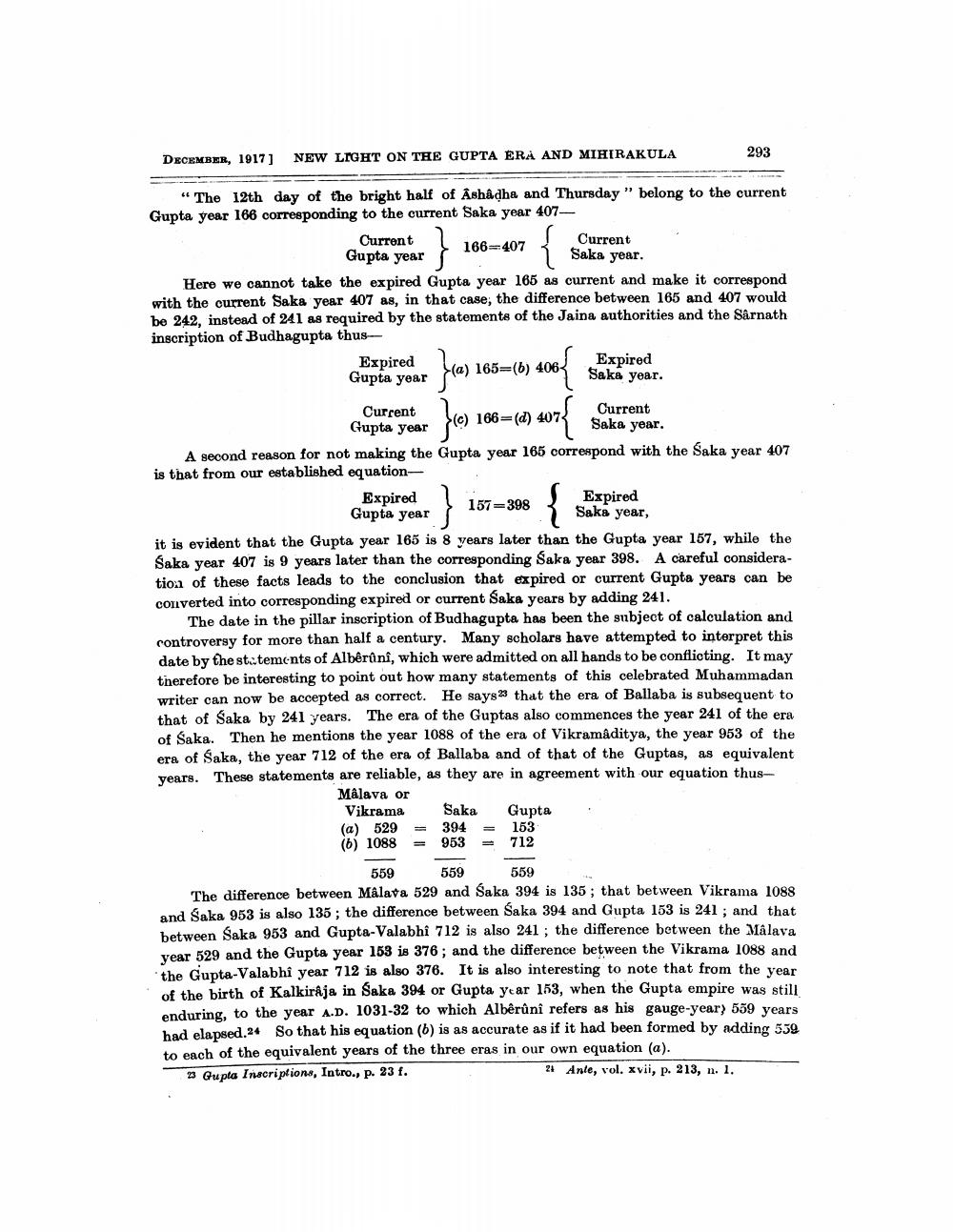Book Title: Indian Antiquary Vol 46
Author(s): Richard Carnac Temple, Devadatta Ramkrishna Bhandarkar
Publisher: Swati Publications
View full book text ________________
DECEMBIR, 1917] NEW LIGHT ON THE GUPTA ERA AND MIHIRAKULA
293
Current
ļ 166=407
Saka year.
“The 12th day of the bright half of Ashâdha and Thursday" belong to the current Gupta year 166 corresponding to the current Saka year 407
Current Gupta year Here we cannot take the expired Gupta year 165 as current and make it correspond with the current Saka year 407 as, in that case, the difference between 165 and 407 would be 242, instead of 241 as required by the statements of the Jaina authorities and the Sârnath inscription of Budhagupta thus
Expired
ya) 165=(b) 4067
) 165—(b) 406 Expired Gupta year
Saka year. Current
Current Gupta year
year ©) 186=(a) 40% Saka year. A second reason for not making the Gupta year 165 correspond with the Saka year 407 is that from our established equation
Expired 1 157398
Expired Gupta year
Saka year, it is evident that the Gupta year 165 is 8 years later than the Gupta year 157, while the Saka year 407 is 9 years later than the corresponding Saka year 398. A careful consideration of these facts leads to the conclusion that expired or current Gupta years can be converted into corresponding expired or current Saka years by adding 241.
The date in the pillar inscription of Budhagupta has been the subject of calculation and controversy for more than half a century. Many scholars have attempted to interpret this date by the statements of Albêrûnî, which were admitted on all hands to be conflicting. It may therefore be interesting to point out how many statements of this celebrated Muhammadan writer can now be accepted as correct. He says 23 that the era of Ballaba is subsequent to that of Saka by 241 years. The era of the Guptas also commences the year 241 of the era of Saka. Then he mentions the year 1088 of the era of Vikramaditya, the year 953 of the era of Saka, the year 712 of the era of Ballaba and of that of the Guptas, as equivalent years. These statements are reliable, as they are in agreement with our equation thus
Mâlava or
Vikrama Saka Gupta (a) 529 = 394 = 153 (6) 1088 = 953 = 712
559 559 559 The difference between Málata 529 and Saka 394 is 135; that between Vikrama 1088 and Saka 953 is also 135; the difference between Saka 394 and Gupta 153 is 241 ; and that between Saka 953 and Gupta-Valabhi 712 is also 241 ; the difference between the Malava year 529 and the Gupta year 153 is 376; and the difference between the Vikrama 1088 and the Gupta-Valabhî year 712 is also 376. It is also interesting to note that from the year of the birth of Kalkiraja in Saka 394 or Gupta year 153, when the Gupta empire was still enduring, to the year A.D. 1031-32 to which Albêrûnî refers as his gauge-year) 559 years had elapsed.24 So that his equation (b) is as accurate as if it had been formed by adding 559 to each of the equivalent years of the three eras in our own equation (a). 23 Gupta Inscriptions, Intro., p. 23 f.
21 Ante, vol. xvii, p. 213, n. 1.
Loading... Page Navigation 1 ... 305 306 307 308 309 310 311 312 313 314 315 316 317 318 319 320 321 322 323 324 325 326 327 328 329 330 331 332 333 334 335 336 337 338 339 340 341 342 343 344 345 346 347 348 349 350 351 352 353 354 355 356 357 358 359 360 361 362 363 364 365 366 367 368 369 370 371 372 373 374 375 376 377 378 379 380 381 382 383 384 385 386 387 388 389 390 391 392 393 394 395 396 397 398 399 400 401 402 403 404 405 406 407 408 409 410 411 412 413 414 415 416 417 418 419 420 421 422 423 424 425 426 427 428 429 430 431 432 433 434 435 436 437 438 439 440 441 442 443 444 445 446 447 448 449 450 451 452 453 454 455 456 457 458 459 460 461 462 463 464 465 466 467 468 469 470 471 472 473 474 475 476 477 478 479 480 481 482 483 484 485 486 487 488 489 490 491 492 493 494 495 496 497 498 499 500 501 502 503 504 505 506 507 508 